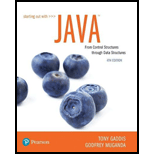
Rectangle Area—Complete the
If you have downloaded the book’s source code from www.pearsonhighered.com/gaddis, you will find a partially written program named AreaRectangle.java in this chapter’s source code folder. Your job is to complete the program. When it is complete, the program will ask the user to enter the width and length of a rectangle, and then display the rectangle’s area. The program calls the following methods, which have not been written:
- getLength—This method should ask the user to enter the rectangle’s length, and then return that value as a double.
- getWidth—This method should ask the user to enter the rectangle’s width, and then return that value as a double.
- getArea—This method should accept the rectangle’s length and width as arguments, and return the rectangle’s area. The area is calculated by multiplying the length by the width.
- • displayData—This method should accept the rectangle’s length, width, and area as arguments, and display them in an appropriate message on the screen.
Want to see the full answer?
Check out a sample textbook solution
Chapter 5 Solutions
EBK STARTING OUT W/JAVA:...DATA...
Additional Engineering Textbook Solutions
Thinking Like an Engineer: An Active Learning Approach (4th Edition)
Modern Database Management
Java: An Introduction to Problem Solving and Programming (8th Edition)
SURVEY OF OPERATING SYSTEMS
Problem Solving with C++ (10th Edition)
Mechanics of Materials (10th Edition)
- Please solve and answer the questions correctly please. Thank you!!arrow_forwardConsidering the TM example of binary sum ( see attached)do the step-by-step of execution for the binary numbers 1101 and 11. Feel free to use the Formal Language Editor Tool to execute it; Write it down the current state of the tape (including the head position) and indicate the current state of the TM at each step.arrow_forwardI need help on inculding additonal code where I can can do the opposite code of MatLab, where the function of t that I enter becomes the result of F(t), in other words, turning the time-domain f(t) into the frequency-domain function F(s):arrow_forward
 EBK JAVA PROGRAMMINGComputer ScienceISBN:9781305480537Author:FARRELLPublisher:CENGAGE LEARNING - CONSIGNMENT
EBK JAVA PROGRAMMINGComputer ScienceISBN:9781305480537Author:FARRELLPublisher:CENGAGE LEARNING - CONSIGNMENT EBK JAVA PROGRAMMINGComputer ScienceISBN:9781337671385Author:FARRELLPublisher:CENGAGE LEARNING - CONSIGNMENT
EBK JAVA PROGRAMMINGComputer ScienceISBN:9781337671385Author:FARRELLPublisher:CENGAGE LEARNING - CONSIGNMENT Microsoft Visual C#Computer ScienceISBN:9781337102100Author:Joyce, Farrell.Publisher:Cengage Learning,
Microsoft Visual C#Computer ScienceISBN:9781337102100Author:Joyce, Farrell.Publisher:Cengage Learning, C++ for Engineers and ScientistsComputer ScienceISBN:9781133187844Author:Bronson, Gary J.Publisher:Course Technology PtrProgramming Logic & Design ComprehensiveComputer ScienceISBN:9781337669405Author:FARRELLPublisher:Cengage
C++ for Engineers and ScientistsComputer ScienceISBN:9781133187844Author:Bronson, Gary J.Publisher:Course Technology PtrProgramming Logic & Design ComprehensiveComputer ScienceISBN:9781337669405Author:FARRELLPublisher:Cengage C++ Programming: From Problem Analysis to Program...Computer ScienceISBN:9781337102087Author:D. S. MalikPublisher:Cengage Learning
C++ Programming: From Problem Analysis to Program...Computer ScienceISBN:9781337102087Author:D. S. MalikPublisher:Cengage Learning





